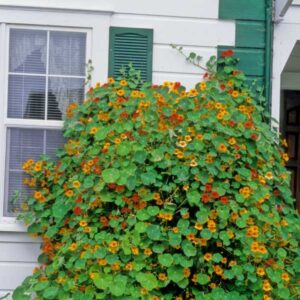Snap Dragon Magic Carpet
$4.49
Antirrhinum Majus Maximus
- Seed Count 3000
- Short Variety
- Perennial
- Height 40 cm
In stock
Description
Snap Dragon Magic Carpet is a lovely dwarf variety of Snapdragon with a tidy, compact habit, perfect for adding colour to autumn and winter gardens. They bloom in a wide assortment of colours including crimson, scarlet, orange, pink and white.
Adaptable and easy to grow, they perform well in pots, baskets and containers and, in the garden they are perfect for beds, borders and rock gardens. They are an all-around excellent garden performer.
The plants have rich green foliage and the, uniquely shaped flowers are beloved by bees and other pollinating insects. Though technically classified as a short lived perennial.
Best planted in small groups in amongst other plants of similar height, though they can also be effective when planted with foliage only plants for striking colour contrast.
They will flower more profusely if the heads are pinched out as they die off. Kids love them, as they appear like talking heads if you pinch the sides.
| Method: Sow direct or seedlings | Soil Temp:8°C - 24°C |
| Cool Mountain: Feb - Apr / Sep - Dec | Position: Part sun |
| Arid: Apr - Sep | Row Spacing: 50 cm |
| Temperate: Feb - May / Set - Oct | Planting Depth 1 mm |
| Sub Tropical: Feb - Sep | Harvest: 115 Days |
| Tropical: Mar - Sep | Plant Height: 40 cm |
Climate and Growing Conditions
Temperature:
- Snapdragons grow best in temperatures between 10°C and 21°C.
- They can tolerate light frosts but may struggle in extreme heat.
Sunlight:
- Plant in a location that receives full sun to partial shade (at least 6 hours of sunlight per day). In hotter regions, provide afternoon shade to protect them from scorching.
Soil:
- Well-draining, fertile soil with a pH between 6.0 and 7.0 is ideal.
- Amend heavy clay soils with compost or organic matter to improve drainage.
Planting Snapdragons
- Sow seeds 6-8 weeks before the last expected frost or directly into the garden in autumn or early spring. See product description for more details.
- Lightly press seeds into the soil (they need light to germinate) and keep the soil moist.
- Germination takes 714 days at temperatures of 8 – 24°C.
- Space plants 50 cm apart.
Watering and Feeding
Watering:
- Keep the soil consistently moist but not waterlogged.
- Water at the base of the plant to avoid wetting the foliage, which can lead to fungal diseases.
- Reduce watering in cooler months.
Feeding:
- Apply a balanced, slow-release fertilizer at planting time.
- Feed every 4-6 weeks with a liquid fertilizer high in phosphorus to encourage blooming.
Pruning and Maintenance
Deadheading:
- Remove spent flowers regularly to encourage continuous blooming and prevent the plant from going to seed.
Pinching:
- Pinch back young plants when they are about 10-15 cm tall to promote bushier growth and more flowers.
Staking:
- Tall varieties may require staking to prevent them from toppling over in windy conditions.
Pests and Diseases
Snapdragons are generally low maintenance but can be affected by a few common issues:
- Aphids: Spray with a strong jet of water or use insecticidal soap.
Rust:
- A fungal disease that causes orange spots on leaves.
- Remove affected leaves and avoid overhead watering.
Powdery Mildew:
- Improve air circulation and avoid overcrowding plants.
- Treat with a fungicide if necessary.
Snails and Slugs:
- Use organic slug pellets or beer traps to protect young plants.
Harvesting
Cut Flowers:
- Snapdragons make excellent cut flowers.
- Harvest when about 1/3 of the flowers on the stem are open.
Overwintering
- In cooler regions, snapdragons may die back in winter but can regrow in spring if the roots are protected with mulch. In warmer regions, they may continue to bloom throughout the winter.
Tips for Success
- Rotate planting locations each year to prevent soilborne diseases.
- Mulch around plants to retain moisture and regulate soil temperature.
- Avoid overwatering, as snapdragons are susceptible to root rot.
Order Times
Seed orders are normally dispatched within three business days. You will receive an email when seeds are mailed out.
Postage Days
Seeds are mailed out Monday to Friday at 1pm. Except for the Friday of long weekends.
Postage Times
WA 2-3 Days: SA,NT 3-5 Days: NSW, ACT, QLD, VIC: 5-7 Days
Carrier
We use Australia Post Letter Postage for the majority of orders
Not only are our seeds packed in recycled paper envelopes, we keep the theme going when we post out website orders. To protect your seeds from moisture and the letter box munchers (snails), we use a very special plastic free material made from plants. They are then put into recycled mailing envelopes. Green all the way 💚🌿
















Reviews
There are no reviews yet